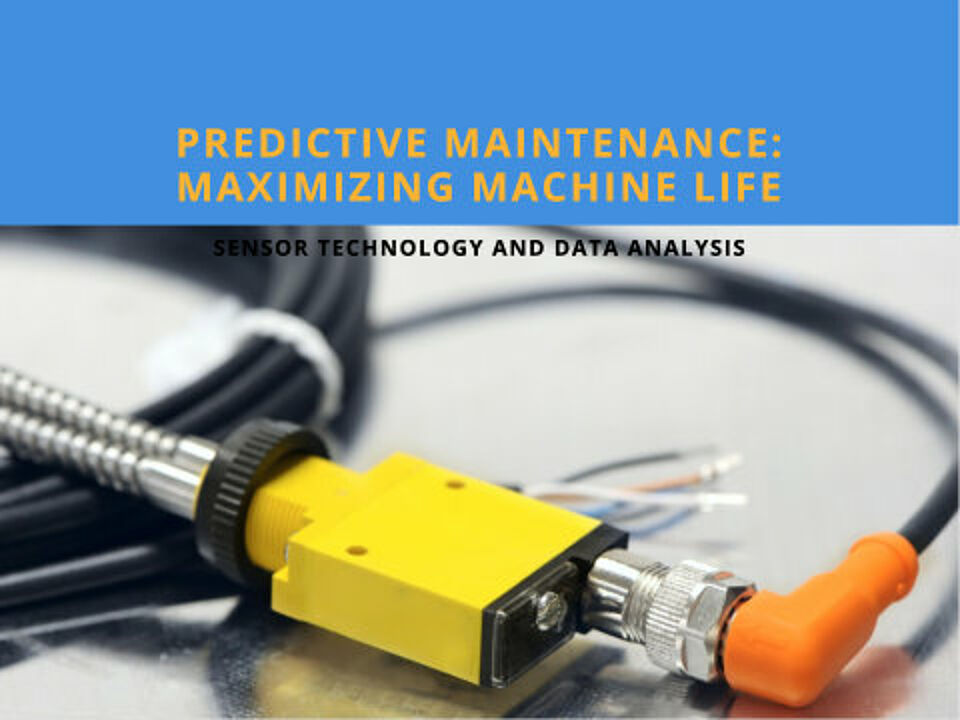
Predictive maintenance, is a central concept in Industry 4.0 that enables the predictive maintenance of machines and systems. The aim is to use predictive maintenance to predict machine failures and optimise maintenance measures in a targeted manner in order to avoid unplanned downtimes.
What is predictive maintenance?
Definition of predictive maintenance
Predictive maintenance is a maintenance method that uses sensor technology and data analysis to monitor the service life of machine components and predict wear and impending defects. This allows maintenance measures to be organised more efficiently and downtimes to be almost completely avoided. By utilising IoT sensors and advanced analysis technologies, companies can integrate predictive maintenance into their maintenance strategy and thus operate their systems more efficiently.
Application of predictive maintenance

Predictive maintenance is an innovative method used in industry to optimise the maintenance of plant and machinery. By using advanced analysis technologies, such as machine learning and data analysis, companies can recognise potential failures and problems at an early stage. This makes it possible to plan maintenance measures in a targeted manner, deploy resources more efficiently and minimise unforeseen downtime. The continuous monitoring of system statuses and the analysis of data make it possible to take preventive measures before costly machine failures occur.
Advantages of predictive maintenance in maintenance
The advantages of predictive maintenance lie in the early detection of problems, the definition of maintenance-related measures and the avoidance of cost-intensive repairs.
By regularly monitoring and analysing machine data, potential failures or defects can be detected and rectified at an early stage before they lead to serious problems. This significantly reduces the downtime of machines and systems, which in turn increases productivity and efficiency.
In addition, predictive maintenance enables more precise planning of maintenance measures, as maintenance is carried out based on actual need rather than rigid schedules. This leads to an optimised use of resources and reduced maintenance costs.
Furthermore, predictive maintenance also allows parts and components to be ordered in good time, which leads to better stock-keeping and a reduced need for spare parts.
To summarise, predictive maintenance in maintenance enables increased system availability, lower maintenance costs and an overall more efficient maintenance strategy.
Difference between predictive maintenance and condition monitoring
The difference between predictive maintenance and condition monitoring lies in the ability of predictive maintenance to use algorithms to predict failures, while condition monitoring primarily involves monitoring the current condition of machines and systems.
How does predictive maintenance help with smart maintenance?
Predictive maintenance supports smart maintenance by enabling predictive maintenance and thus increasing plant availability and production efficiency. In addition, predictive maintenance enables better real-time diagnosis of plant conditions through the continuous monitoring and analysis of sensor data, which can optimise the performance and efficiency of the systems.

How is predictive maintenance used in practice?
Examples of the use of predictive maintenance on systems
Predictive maintenance is used in practice by applying various data analysis and forecasting techniques to predict the condition of systems and machines and avoid the resulting failures. One example of this is the use of sensor and machine data to monitor the wear of components and plan maintenance measures at an early stage. Another application is analysing historical maintenance data to identify patterns of failures and derive predictions for future maintenance requirements. Another example is the use of machine learning algorithms to monitor systems in real time in order to recognise unusual operating conditions and prevent potential failures. In practice, predictive maintenance is often used in the manufacturing industry, in aircraft maintenance and in the power generation sector.
Forecasting machine failures and preventive measures
Predicting machine failures and developing preventive measures are crucial for the efficiency and safety of production facilities. By relying on advanced data analysis and monitoring technologies, engineers can predict potential failures at an early stage and take appropriate measures to minimise the impact on production. Preventative measures can include regular maintenance and servicing of machinery, implementation of spare parts warehouses and operator training. In addition, sensors and monitoring systems can be used to monitor the condition of machines in real time and automatically generate alerts in the event of deviations from normal values. By proactively implementing predictive and preventive measures, companies can improve the reliability of their production facilities.
Optimisation of maintenance planning through the use of predictive maintenance
By using predictive maintenance, maintenance planning can be optimised as it is based on data and analyses to predict failures and take preventive measures. Preventive maintenance measures can be planned in a more targeted and efficient manner as they are based on actual requirements and not on fixed time intervals. This not only leads to cost savings, but also to improved plant availability and reliability. The introduction of predictive maintenance can help to reduce maintenance costs while maximising uptime. It also makes it possible to better manage maintenance costs and utilise resources more effectively.
Smart maintenance: efficient application of predictive maintenance
Smart maintenance refers to the efficient application of predictive maintenance techniques to optimise the performance of systems and machines. By using predictive analyses and IoT sensors, potential problems can be detected and rectified at an early stage before they lead to costly breakdowns. This makes it possible to carry out maintenance work in a more targeted and efficient manner, as it can no longer be carried out on a scheduled basis, but rather in line with demand. The use of smart maintenance can therefore lead to improved system availability, a longer service life for machines and a reduction in maintenance costs. In addition, predictive maintenance can also help to optimise energy consumption and reduce the environmental impact, as machines and systems are only serviced when it is actually necessary.
Predictive maintenance to avoid unplanned downtime
Regular maintenance and inspection work on machines and systems enables potential faults to be recognised and rectified at an early stage. This maintains the production capability of the systems and avoids expensive downtimes. With the help of sensors and modern technology, data can also be collected and analysed in order to continuously monitor the condition of the systems and take preventative measures. In this way, breakdowns and repairs can be planned in advance, resulting in more efficient and cost-effective maintenance.

What role do the application areas of condition monitoring and predictive maintenance play?
Principles of condition monitoring and predictive maintenance
Condition monitoring monitors the current condition of machines and systems, while predictive maintenance uses data analyses to predict future failures. Both topics play an important role in the maintenance and servicing of plant and machinery. They enable companies to recognise potential problems at an early stage and rectify them before breakdowns occur. This allows them to reduce unplanned downtime and increase plant productivity.
Use of sensor technology and data analysis in condition monitoring and predictive maintenance
Sensors and data analysis are used in both condition monitoring and predictive maintenance to monitor and analyse machine data.
Areas of application for condition monitoring and predictive maintenance
Condition monitoring and predictive maintenance are used in the monitoring of machines and systems to avoid unplanned downtimes and optimise maintenance measures.
Comparison of predictive maintenance solutions and classic preventive maintenance
Compared to classic preventive maintenance, predictive maintenance uses algorithms and data analyses to predict failures more precisely and carry out maintenance measures in a more targeted manner.
With classic preventive maintenance, maintenance work is carried out at regular intervals, regardless of the actual condition of the systems or machines. This can result in maintenance work being carried out either too early or too late, which is inefficient and can lead to unnecessary costs.
Predictive maintenance, on the other hand, continuously analyses data from sensors to monitor the condition of systems and machines in real time. Algorithms and machine learning can be used to recognise patterns and anomalies that indicate future failures. Based on these precise predictions, maintenance measures can be carried out in a more targeted and timely manner, which increases plant uptime and reduces maintenance costs.
Another difference lies in the flexibility and adaptability of the maintenance plans. While maintenance intervals are fixed in traditional preventive maintenance, predictive maintenance allows maintenance schedules to be customised based on the actual needs of the systems and machines.
Machine learning and predictive maintenance: using algorithms to predict failures
Predictive maintenance uses machine learning and algorithms to predict future failures based on collected data and determine targeted maintenance measures.
By analysing various data, such as temperature, pressure, vibration and energy consumption, machine learning can identify patterns that indicate impending problems. These patterns can then be used to make predictions about potential failures and plan maintenance measures accordingly.
Predictive maintenance algorithms are continuously trained and improved to make more accurate predictions. With the ongoing development of machine learning and artificial intelligence, these predictions are becoming increasingly precise and can help companies to optimise the maintenance and use of their systems and machines.

What are the prerequisites for the successful implementation of predictive maintenance?
Utilising IoT and data volumes for predictive maintenance
The use of IoT and big data makes it possible to analyse and forecast machine and process data for predictive maintenance. With the help of predictive maintenance AI, important data is analysed in a model based on machine learning and big data.
Analysing process and machine data for the implementation of predictive maintenance
By analysing process and machine data, companies can drive forward the implementation of predictive maintenance in a targeted manner and increase the efficiency of maintenance measures.
Efficient evaluation of collected data to almost completely avoid downtimes
By efficiently evaluating the collected data, predictive maintenance makes it possible to almost completely avoid unplanned downtimes and optimise plant availability.
Linking and monitoring machine-related data in production plants
The linking and monitoring of machine-related data in production plants is a prerequisite for the successful implementation of predictive maintenance.
Networked systems: conditions for the successful implementation of predictive maintenance
Networked systems and the monitoring of machine data can create the conditions for the successful implementation of predictive maintenance.
Frequently asked questions - Predictive Maintenance
FAQs
What is predictive maintenance?
Predictive maintenance is a technique that enables the preventive maintenance of machines and systems using data and machine learning. By analysing sensor data and other data sources, potential failures can be predicted and preventative measures can be taken to minimise unplanned downtime.
What role does data play in predictive maintenance?
Data plays a central role in predictive maintenance. It forms the basis for predicting machine failures by providing information about the condition of components and machines. A reliable database is therefore a prerequisite for effective predictive maintenance.
What are typical application examples for predictive maintenance?
Typical application examples for predictive maintenance are the monitoring of turbines in wind turbines and the predictive determination of spare parts requirements or dedicated spare parts per inspection and the optimisation of inspection intervals in industry.
How does predictive maintenance differ from reactive maintenance?
In contrast to reactive maintenance, which is based on unplanned breakdowns, predictive maintenance relies on the early prediction of breakdowns using data analysis and preventive measures.
Which technologies play a role in predictive maintenance?
Predictive maintenance uses technologies such as the Internet of Things (IoT) and machine learning to analyse large volumes of data from machines and systems and gain insights for maintenance.
What are the benefits of predictive maintenance?
Predictive maintenance offers the opportunity to reduce unplanned downtime, extend the service life of machine components and increase the efficiency of maintenance processes.
What role does predictive maintenance play in the context of Industry 4.0?
Predictive maintenance plays an important role in Industry 4.0 as it helps to optimise the use of resources in production and increase plant availability.
How does a predictive maintenance system work?
A predictive maintenance system continuously collects data, analyses it in real time and generates predictions about the condition of machines. Preventive measures can be initiated based on these predictions.
What kind of machine failures can predictive maintenance predict?
Predictive maintenance can predict various types of machine failures, such as component wear, defects in electronics or problems with machine performance.
What are the prerequisites for the successful implementation of predictive maintenance?
A reliable database, the integration of sensor data into the maintenance system and the availability of expertise in the field of data analysis and maintenance are important prerequisites for the successful implementation of predictive maintenance.
Maybe also interesting:
Maintenance software for reliable processes - EcholoN CMMS
Blog article: CMMS - Computerised Maintenance Management System
Blog article: Maintenance, inspection, repair and overhaul
Blog article: What is Preventive Maintenance?
Blog article: Maintenance and servicing - relevant key performance indicators (KPIs)
Blog article: Computer Aided Facility Management - CAFM
Blog article: Internet of Things - IoT
Blog article: Introduction to Industry 4.0
